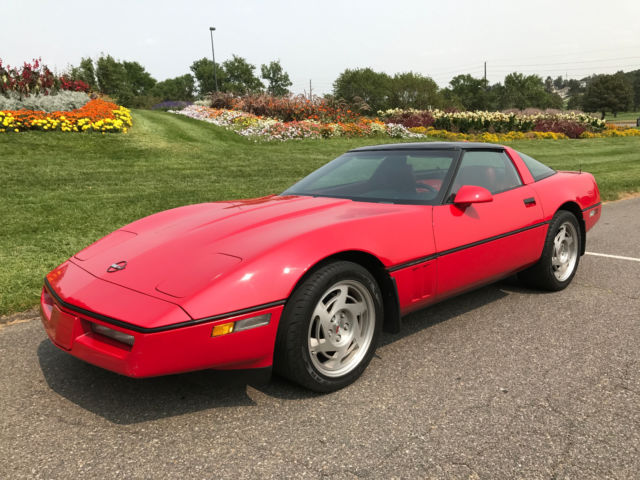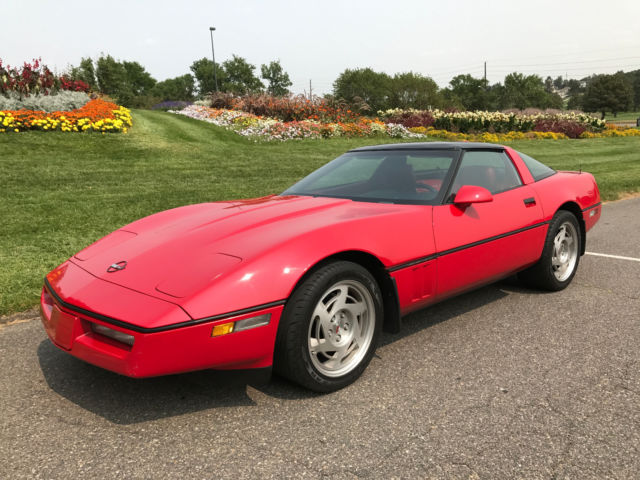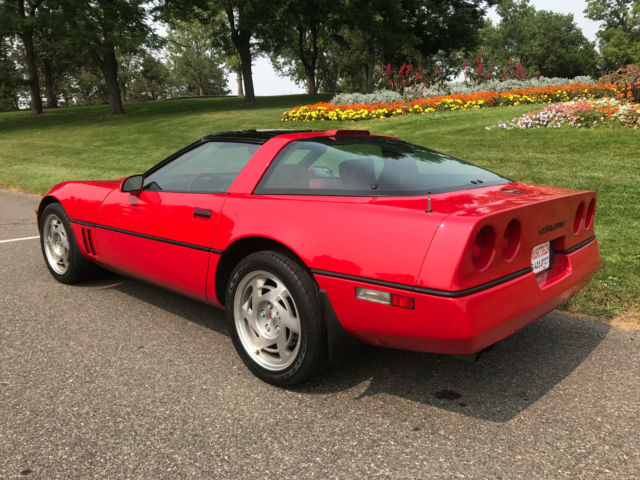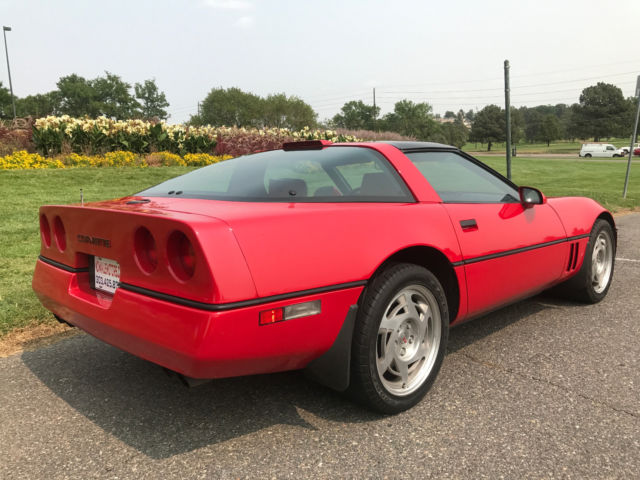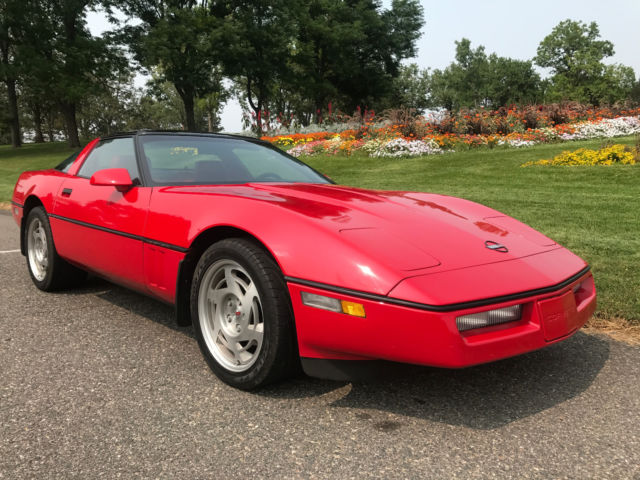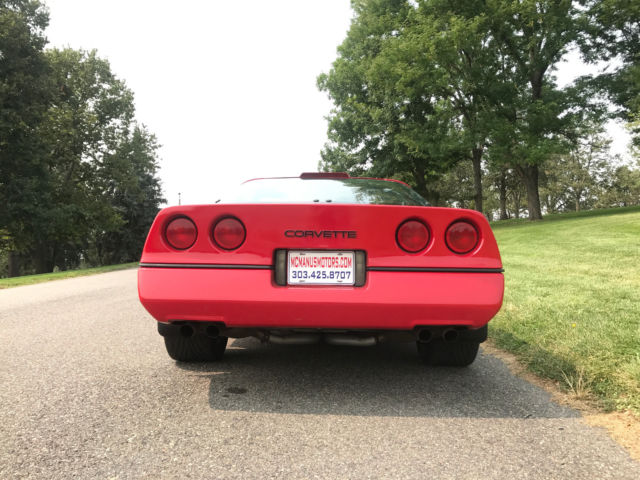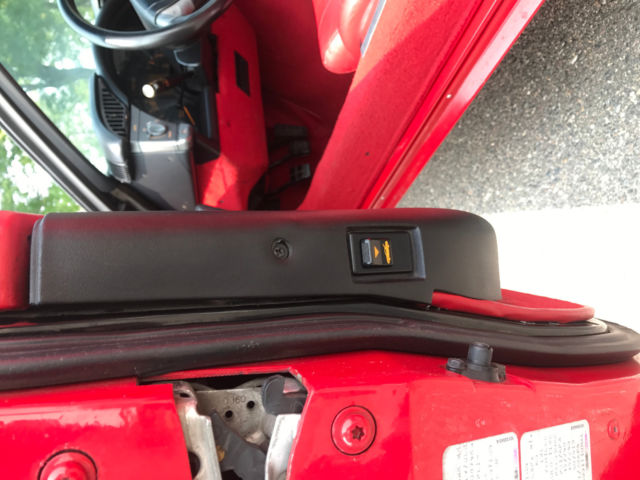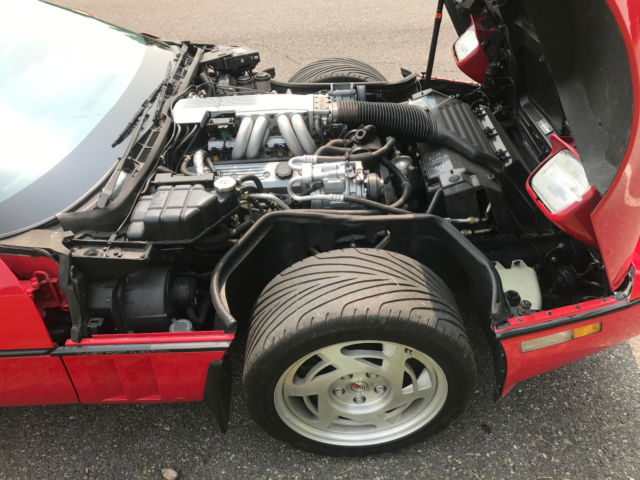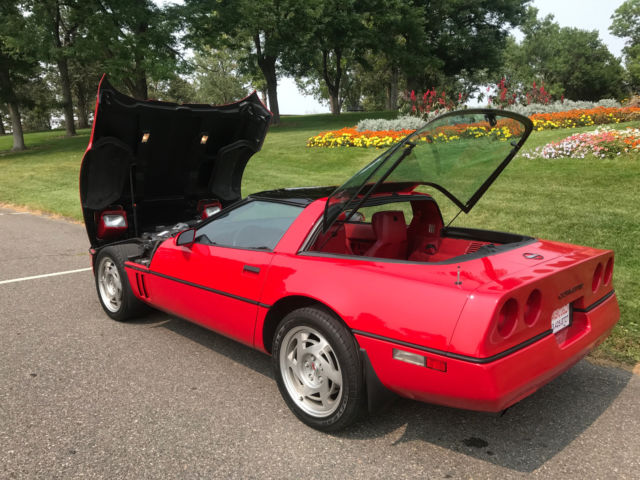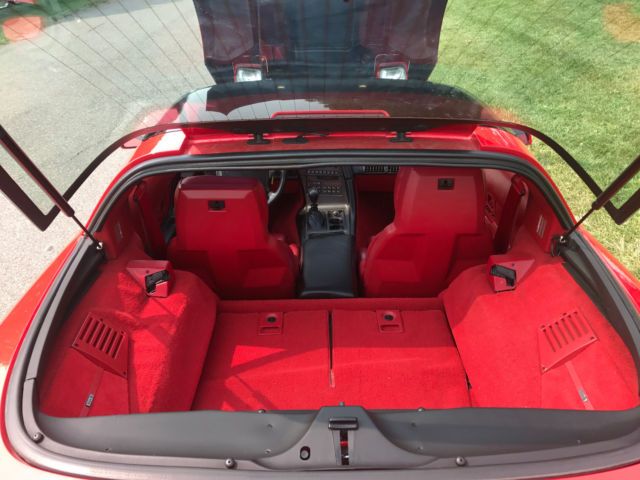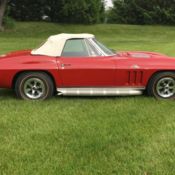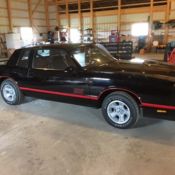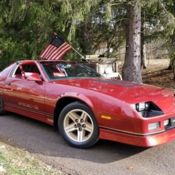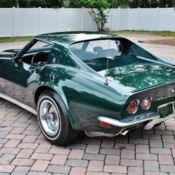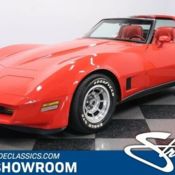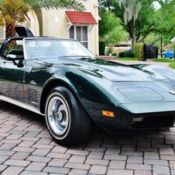ORIGINAL LRC 6SP AC RED LEATHER 86K VINTAGE ORIGINAL FACTORY COMPLETE CORVETTE R
Technical specifications of Chevrolet Corvette 1990
| Price: | - |
|---|---|
| Condition: | Certified pre-owned |
| Item location: | Wheat Ridge, Colorado, United States |
| Make: | Chevrolet |
| Model: | Corvette |
| Trim: | LT1 |
| Year: | 1990 |
| Mileage: | 86,132 |
| VIN: | 1G1YY2383L5115944 |
| Color: | RED |
| Engine size: | 5.7L 350 LT1 |
| Number of cylinders: | 8 |
| Power options: | Air Conditioning, Cruise Control, Power Locks, Power Windows, Power Seats |
| Fuel: | PETROL |
| Transmission: | Manual |
| Drive type: | RWD |
| Interior color: | RED |
| Safety options: | Anti-Lock Brakes |
| Vehicle Title: | Clear |
| You are interested? | Contact the seller! |
Description
THIS IS THE ORIGINAL LRC THAT PRINCE WROTE THE SONG ABOUT. GREAT CLEAN CAR ZERO LEAKS, NO ISSUES, CLEAN FAX CLEAN TITLE EMISSIONS GUARANTEED VERY CLEAN CAR PURCHASED THROUGH MECUM AND IS THE FASTEST CAR IN MY GARAGE BUT TIME TO MOVE ON. GREAT CLEAN CAR HOPE IT MAKES IT TO A GREAT HOME.Chevrolet Corvette From Wikipedia, the free encyclopedia This article is about the sports car. For other uses, see Corvette (disambiguation).| Chevrolet Corvette logos over time |
| Chevrolet (General Motors) |
| Sting Ray (1963–1967) Stingray (1969–1976, 2014–present) |
| 1953–present |
1953–1982, 1984–present
|
United States:
|
| Sports car |
| 2-door coupé 2-door convertible |
|
|
The Chevrolet Corvette, known colloquially as the Vette[1] or Chevy Corvette, is a sports car manufactured by Chevrolet. The car has been produced through seven generations.[2][3] The first model, a convertible, was introduced at the GM Motorama in 1953 as a concept show car. Myron Scott is credited for naming the car after the type of small, maneuverable warship called a corvette.[4] Originally built in Flint, Michigan and St. Louis, Missouri, the Corvette is currently manufactured in Bowling Green, Kentucky and is the official sports car of the Commonwealth of Kentucky.
Contents- 1 History
- 1.1 First generation (C1; 1953–1962)
- 1.2 Second generation (C2; 1963–1967)
- 1.3 Third generation (C3; 1968–1982)
- 1.4 Fourth generation (C4; 1984–1996)
- 1.5 Fifth generation (C5; 1997–2004)
- 1.6 Sixth generation (C6; 2005–2013)
- 1.7 Seventh generation (C7; 2014–present)
- 2 Awards
- 3 NASA Corvettes
- 4 Concept cars
- 5 Production
- 6 Owner demographics
- 7 Racing
- 7.1 C5-R
- 7.2 C6.R
- 7.3 C7.R
- 7.4 Indianapolis 500 pace cars
- 8 See also
- 9 References
- 10 External links
The first generation of Corvette was introduced late in the 1953 model year. Originally designed as a show car for the 1953 Motorama display at the New York Auto Show, it generated enough interest to induce GM to make a production version to sell to the public. First production was on June 30, 1953.[5][6][7]
This generation was often referred to as the "solid-axle" models (the independent rear suspension was not introduced until the second generation).[8] Three hundred hand-built polo white Corvette convertibles were produced for the 1953 model year.[9]
The 1954 model year vehicles could be ordered in Pennant Blue, Sportsman Red, Black, or Polo White; 3,640 were built, and sold slowly.
The 1955 model offered a 265cuin (4.34L) V8 engine as an option. With a large inventory of unsold 1954 models, GM limited production to 700 for 1955. With the new V8, the 0–60mph time improved by 1.5 seconds.[7]
A new body was introduced for the 1956 model featuring a new "face" and side coves; the taillamp fins were also gone.[10] An optional fuel injection system was made available in the middle of the 1957 model year. It was one of the first mass-produced engines in history to reach 1bhp (0.75kW) per cubic inch (16.4 cubic cm) and Chevrolet's advertising agency used a "one hp per cubic inch" slogan for advertising the 283bhp (211kW) 283cuin (4.64L) Small-Block engine.[11] Other options included power windows (1956), hydraulically operated power convertible top (1956), heavy duty brakes and suspension (1957), and four speed manual transmission (late 1957).[11] Delco Radio transistorized signal-seeking "hybrid" car radio, which used both vacuum tubes and transistors in its radio's circuitry (1956 option).[12][13]
The 1958 Corvette received a body and interior freshening which included a longer front end with quad headlamps, bumper exiting exhaust tips, a new steering wheel, and a dashboard with all gauges mounted directly in front of the driver.[14] Exclusive to the 1958 model were hood louvers and twin trunk spears.[14] The 1959–60 model years had few changes except a decreased amount of body chrome and more powerful engine offerings.[15]
In 1961, the rear of the car was completely redesigned with the addition of a "duck tail" with four round lights. The light treatment would continue for all following model year Corvettes until 2014.[16] In 1962, the Chevrolet 283cuin (4.64L) Small-Block was enlarged to 327cuin (5.36L). In standard form it produced 250bhp (190kW). For an extra 12% over list price, the fuel-injected version produced 360bhp (270kW),[17] making it the fastest of the C1 generation. 1962 was also the last year for the wrap around windshield, solid rear axle, and convertible-only body style.[18] The trunk lid and exposed headlamps did not reappear for many decades.[19]
-
1954 Corvette convertible
-
1956 Corvette convertible
-
1959 Corvette convertible (rear)
-
1960 Corvette convertible
-
1956 Chevrolet Corvette transistorized "hybrid" (vacuum tubes and transistors) car radio option
The second generation (C2) Corvette, which introduced Sting Ray to the model, continued with fiberglass body panels, and overall, was smaller than the first generation. The C2 was later referred to as mid-years.[20] The car was designed by Larry Shinoda with major inspiration from a previous concept design called the "Q Corvette," which was created by Peter Brock and Chuck Pohlmann under the styling direction of Bill Mitchell.[21] Earlier, Mitchell had sponsored a car known as the "Mitchell Sting Ray" in 1959 because Chevrolet no longer participated in factory racing. This vehicle had the largest impact on the styling of this generation, although it had no top and did not give away what the final version of the C2 would look like.[22] The third inspiration was a Mako Shark Mitchell had caught while deep-sea fishing.[23]
Production started for the 1963 model year and ended in 1967. Introducing a new name, "Sting Ray", the 1963 model was the first year for a Corvette coupé and it featured a distinctive tapering rear deck (a feature that later reappeared on the 1971 "Boattail" Buick Riviera) with, for 1963 only, a split rear window. The Sting Ray featured hidden headlamps, non-functional hood vents, and an independent rear suspension.[24] Corvette chief engineer Zora Arkus-Duntov never liked the split rear window because it blocked rear vision, but Mitchell thought it to be a key part of the entire design. Maximum power for 1963 was 360bhp (270kW) and was raised to 375bhp (280kW) in 1964. Options included electronic ignition, the breakerless magnetic pulse-triggered Delcotronic first offered on some 1963 Pontiac models.[25] On 1964 models the decorative hood vents were eliminated and Duntov, the Corvette's chief engineer, got his way with the split rear window changed to a full width window.
1965 Corvette Sting Ray coupeFour-wheel disc brakes were introduced in 1965, as was a "big block" engine option: the 396cuin (6.49L) V8. Side exhaust pipes were also optionally available in 1965, and continued to be offered through 1967. The introduction of the 425bhp (317kW) 396cuin (6.49L) big block in 1965 spelled the beginning of the end for the Rochester fuel injection system.[26] The 396cuin (6.49L) option cost US$292.70 while the fuel injected 327cuin (5.36L) engine cost US$538.00. Few people could justify spending US$245.00 more for 50bhp (37kW) less, even though FI could deliver over 20 mpg on the highway and would keep delivering fuel despite high G-loading in corners taken at racing speeds. Another rare '63 and '64 option was the Z06 competition package, which offered stiffer suspension, bigger, multi-segment lined brakes with finned drums and more, only a couple hundred coupes and ONE convertible were factory-equipped this way in 1963. With only 771 fuel-injected cars built in 1965, Chevrolet discontinued the option at the end of the '65 production, having introduced a less-expensive big block 396 engine rated at 425hp in the middle of the production year and selling over 2,000 in just a few months. For 1966, Chevrolet introduced an even larger 427cuin (7.00L) Big Block version. Other options available on the C2 included the Wonderbar auto-tuning AM radio, AM-FM radio (mid-1963), air conditioning (late-1963), a telescopic steering wheel (1965), and headrests (1966). The Sting Ray's independent rear suspension was successfully adapted for the new-for-1965 Chevrolet Corvair, which solved the quirky handling problems of that unique rear-engine compact.[27]
1967 Corvette Sting Ray convertible1967 was the final year for the C2 generation. The 1967 model featured restyled fender vents, less ornamentation, and back-up lamps which were on the inboard in 1966 were now rectangular and centrally located. The first use of all four taillights in red started in 1961 and was continued thru the C-2 line-up except for the 1966. The 1967 and subsequent models continuing on all Corvettes since. 1967 had the first L88 engine option which was rated at 430bhp (320kW), but unofficial estimates place the actual output at 560bhp (420kW) or more.[28] Only twenty such engines were installed at the factory. From 1967 (to 1969), the Holley triple two-barrel carburetor, or Tri-Power, was available on the 427 L89 (a $368 option, on top of the cost for the high-performance 427).[29] Despite these changes, sales slipped over 15%, to 22,940 (8,504 coupes, off close to 15%, and 14,436 convertibles, down nearly 19%).[30]
Duntov came up with a lightweight version of the C2 in 1962. Concerned about Ford and what they were doing with the Shelby Cobra, GM planned to manufacture 100 Grand Sport Corvettes, but only five were actually built.[31] They were driven by historic drivers such as Roger Penske, A. J. Foyt, Jim Hall, and Dick Guldstrand among others. Today the five cars (001-005) are all held by private owners, and are among the most coveted and valuable Corvettes ever built.[32] 002 is exhibited in the Simeone Foundation Automotive Museum and is in running condition.[33]
Third generation (C3; 1968–1982)Main article: Chevrolet Corvette (C3) 1969 Corvette Stingray convertible 1971 Corvette Stingray coupeThe third generation Corvette, patterned after the Mako Shark II concept car, was introduced for the 1968 model year and was in production until 1982. C3 coupes featured the first use of T-top removable roof panels. It introduced monikers that were later revived, such as LT-1, ZR-1, Z07 and Collector Edition. In 1978, the Corvette's 25th anniversary was celebrated with a two-tone Silver Anniversary Edition and an Indy Pace Car replica edition of the C3. This was also the first time that a Corvette was used as a Pace Car for the Indianapolis 500.[34]
Engines and chassis components were mostly carried over from the C2, but the body and interior were new. The 350cuin (5.7L) engine replaced the old 327cuin (5.36L) as the base engine in 1969, but power remained at 300bhp (224kW). 1969 was the only year for a C3 to optionally offer either a factory installed side exhaust or normal rear exit with chrome tips. The all-aluminum ZL1 engine was also new for 1969; the special big-block engine was listed at 430-hp (320kW), but was reported to produce 560hp (420kW) and propelled a ZL1 through the 1/4 mile in 10.89 seconds.[35]
There was an extended production run for the 1969 model year due a lengthy labor strike, which meant sales were down on the 1970 models, to 17,316.[36] 1970 small-block power peaked with the optional high compression, high-revving LT-1 that produced 370bhp (276kW). The 427 big-block was enlarged to 454cuin (7.44L) with a 390bhp (291kW) rating. The ZR-1 special package was an option available on the 1970 through 1972 model years, and included the LT-1 engine combined with special racing equipment. Only 53 ZR-1's were built.[37]
In 1971, to accommodate regular low-lead fuel with lower anti-knock properties, the engine compression ratios were lowered which resulted in reduced power ratings. The power rating for the 350cuin (5.7L) L48 base engine decreased from 300 to 270 horsepower and the optional special high performance LT1 engine decreased from 370 to 330 horsepower. The LS5 454 cu in (7.4 L) motor was carried over and produced 365hp (272kW). Offered in ‘71 only was the LS6 454 cu in (7.4 L) big-block featuring aluminum heads and delivering 425 hp (317 kW), highest of the 1970-72 series, and could be ordered with an automatic transmission. For the 1972 model year, GM moved to the SAE Net measurement which resulted in further reduced, but more realistic, power ratings than the previous SAE Gross standard.[38] Although the 1972 model's 350cuin (5.7L) horsepower was actually the same as that for the 1971 model year, the lower net horsepower numbers were used instead of gross horsepower. The L48 base engine was now rated at 200bhp (150kW) and the optional LT1 engine was now rated at 270bhp (200kW).[19] 1974 models had the last true dual exhaust system that was dropped on the 1975 models with the introduction of catalytic converters requiring the use of no-lead fuel. Engine power decreased with the base ZQ3 engine producing 165bhp (123kW), the optional L82's output 205bhp (153kW), while the 454 big-block engine was discontinued. Gradual power increases after 1975 peaked with the 1980 model's optional L82 producing 230bhp (172kW).[15] The 1981 L82 had 190bhp (142kW) and the 1982 L82 had 200bhp (149kW).
1974 Corvette Stingray coupe Corvette Sting Ray tail lights. Corvette Sting Ray detail.Styling changed subtly throughout the generation until 1978 for the car's 25th anniversary. The Sting Ray nameplate was not used on the 1968 model, but Chevrolet still referred to the Corvette as a Sting Ray; however, the 1969 (through 1976) models used the "Stingray" name as one word, without the space.[39] In 1970, the body design was updated including fender flares, and interiors were refined, which included redesigned seats, and indication lights near the gear shift that were an early use of fiber optics . Due to government regulation, the 1973 Corvette's chrome front bumper was changed to a 5-mile-per-hour (8km/h)system with a urethane bumper cover.[40] 1973 Corvettes are unique in that sense, as they are the only year where the front bumper was polyurethane and the rear retained the chrome two-piece bumper set. 1973 was also the last year chrome bumpers were used. The optional wire-spoked wheel covers (left) were offered for the last time in 1973. Only 45 Z07 were built in 1973. From 1974 onwards both the front and rear bumpers were polyurethane.[6]
In 1974, a 5-mile-per-hour (8km/h) rear bumper system with a two-piece, tapering urethane bumper cover replaced the Kamm-tail and chrome bumper blades, and matched the new front design from the previous year. 1975 was the last year for the convertible, (which did not return for 11 years) and Dave McLellan succeeded Zora Arkus-Duntov as the Corvette's Chief Engineer.[41] For the 1976 models the fiberglass floor was replaced with steel panels to provide protection from the catalytic converter's high operating temperature. For 15 model years the names Corvette, Sting Ray, and Stingray were synonymous. 1977 was last year the tunneled roof treatment with vertical back window was used, in addition leather seats were available at no additional cost for the first time. The black exterior color returned after a six-year absence.[42]
1978 Corvette Indy 500 Pace Car Edition (rear)The 1978 25th Anniversary model introduced the fastback glass rear window and featured a new interior and dashboard. Corvette's 25th anniversary was celebrated with the Indy 500 Pace Car limited edition and a Silver Anniversary model featuring silver over gray lower body paint. All 1979 models featured the previous year's pace car seats and offered the front and rear spoilers as optional equipment.[20] 53,807 were produced for the model year, making 1979 the peak production year for all versions of the Corvette. Sales have trended downward since then.[43] In 1980, the Corvette received an integrated aerodynamic redesign that resulted in a significant reduction in drag. After several years of weight increases, 1980 Corvettes were lighter as engineers trimmed both body and chassis weight.[14] In mid-1981, production shifted from St. Louis, Missouri to Bowling Green, Kentucky, and several two-tone paint options were offered. The 1981 models were the last available with a manual transmission until well into the 1984 production run. In 1982, a fuel-injected engine returned, and a final C3 tribute Collectors Edition featured an exclusive, opening rear window hatch.[14]
Fourth generation (C4; 1984–1996)Main article: Chevrolet Corvette (C4) 1984 Corvette with targa top open 1988 Corvette coupeThe fourth generation Corvette was the first complete redesign of the Corvette since 1963. Production was to begin for the 1983 model year but quality issues and part delays resulted in only 43 prototypes for the 1983 model year being produced that were never sold. All of the 1983 prototypes were destroyed or serialized to 1984 except one with a white exterior, medium blue interior, L83 350 ci, 205bhp V8, and 4-speed automatic transmission.[5] After extensive testing and modifications were completed, it was initially retired as a display sitting in an external wall over the Bowling Green Assembly Plant's employee entrance. Later this only surviving 1983 prototype was removed, restored and is now on public display at the National Corvette Museum in Bowling Green, Kentucky. It is still owned by GM.[44][45] On February 12, 2014, it was nearly lost to a sinkhole which opened up under the museum. Eight other Corvettes were severely damaged.[46]
Regular fourth generation production began on January 3, 1983; the 1984 model year and delivery to customers began in March 1983. The 1984 model carried over the 350cuin (5.7L) L83 slightly more powerful (5bhp) "Crossfire" V8 engine from the final 1982 third generation model.[20] New chassis features were aluminum brake calipers and an all-aluminum suspension for weight savings and rigidity. The new one piece targa top had no center reinforcement. A new electronic dashboard with digital liquid crystal displays for the speedometer and tachometer was standard. Beginning in 1985, the 230bhp (170kW) L98 engine with tuned port fuel injection became the standard engine.[5]
1986 Corvette convertible Indy 500 Pace Car EditionSeptember 1984 through 1988 Corvettes offered a Doug Nash designed "4+3" transmission – a 4-speed manual coupled to an automatic overdrive on the top three gears. It was designed to help the Corvette meet U.S. fuel economy standards.[47] Since 1981 (when it was last offered), a manual transmission returned to the Corvette starting with production in late 1984. The transmission proved to be problematic and was replaced by a modern ZF 6-speed manual transmission in 1989.[48]
In 1986, the second Corvette Indy Pace Car was released. It was the first convertible Corvette since 1975. A Center High Mounted Signal Light (CHMSL) – a third center brake light – was added in 1986 to comply with safety regulations. While the color of the pace car used in the race was yellow, all 1986 convertibles also had an Indy 500 emblem mounted on the console, making any color a "pace car edition". In 1987, the B2K twin-turbo option became available from the factory. The Callaway Corvette was a Regular Production Option (RPO B2K). The B2K option coexisted from 1990 to 1991 with the ZR-1 option, which then replaced it. Early B2Ks produced 345bhp (257kW) and 450lb·ft (610N·m);[49] later versions boasted 450bhp (336kW) and 613lb·ft (831N·m).[50]
1988 saw the 35th Anniversary Edition of the Corvette. Each of these featured a special badge with an identification number mounted next to the gear selector, and were finished with a white exterior, wheels, and interior.[14] In 1991, all Corvettes received updates to the body, interior, and wheels. The convex rear fascia that set the 1990 ZR-1 apart from the base model was now included on L98 Corvettes, making the styling of the expensive ZR-1 even closer to that of the base cars. The most obvious difference remaining between the base and ZR-1 models besides the wider rear wheels was the location of the CHMSL, which was integrated into the new rear fascia used on the base model, but remained at the top of the rear-hatch on the ZR-1's.[19]
1992 Corvette ZR-1For the 1992 model year, the 300bhp (220kW) LT1 engine was introduced, an increase of 50bhp (37kW) over 1991's L98 engine. This engine featured reverse-flow cooling (the heads were cooled before the block), which allowed for a higher compression ratio of 10.5:1. A new distributor was also debuted. Called "Optispark", the distributor was driven directly off the front of the camshaft and mounted in front of the timing cover, just above the crankshaft and harmonic balancer.[19] Also new for 1992 was Acceleration Slip Regulation (ASR), a form of traction control which utilized the Corvette's brakes, spark retard, and throttle close-down to prevent excessive rear wheel spin and possible loss of control. The traction control device could be switched off if desired.[14]
1996 Corvette Grand SportA special 40th Anniversary Edition was released in 1993, which featured a commemorative Ruby Red color, 40th anniversary badges, and embroidered seat backs. The 1993 Corvette also marked the introduction of the Passive Keyless Entry System, making it the first GM car to feature it. Production of the ZR-1 ended in 1995, after 6,939 cars had been built.[47] 1996 was the final year of C4 production, and featured special models and options, including the Grand Sport and Collector Edition, OBD II (On-Board Diagnostics), run flat tires, and the LT4 engine. The 330bhp (246kW) LT4 V8 was available only with a manual transmission, while all 300bhp (224kW) LT1 Corvettes used automatic transmissions.[26]
Chevrolet released the Grand Sport (GS) version in 1996 to mark the end of production of the C4 Corvette. The Grand Sport moniker was a nod to the original Grand Sport model produced in 1963. A total of 1,000 GS Corvettes were produced, 810 as coupes and 190 as convertibles.[26] The 1996 GS came with the high-performance LT4 V8 engine, producing 330bhp (246kW) and 340lb·ft (460N·m). The Grand Sport came only in Admiral Blue with a white stripe down the middle, and black wheels and two red stripes on the front left wheel arch.[51]
Fifth generation (C5; 1997–2004)Main article: Chevrolet Corvette (C5) Corvette C5 coupe Corvette C5 convertibleThe C5 was the most completely redesigned Corvette since the Corvette's inception in 1953.(Corvette Racing, David Kimble, 2012). Production of the C5 Corvette actually began in 1996 but quality/manufacturing snafus saw its release to the public in mass delayed until 1997, and continuing through the 2004 model year. The C5 was a completely new design that featured many new concepts and manufacturing breakthroughs that would be carried forward to the C6 & C7. It had a top speed of 176mph (283km/h) and was judged by the automotive press as a breakthrough with vastly improved dynamics in nearly every area over the previous C4 design. The list of all new innovations include:
- Industry leading 0.29 Drag Coefficient
- Near 50/50 weight distribution (actually 51%F/49%R) due to the all new powertrain layout
- The FIRST Corvette to actually use an Upper Rear Suspension Arm, instead of the Drive Shafts performing double duty as the Upper locator arm
- An All New Chassis design that was more akin to a Stressed Monocoque than the former Ladder designs which featured an all new Stressed Center Tunnel design for increased torsional rigidity
- All New Hyrdo-Formed side Rails increased torsional rigidity more than 4 times that of the C4 and previous Corvette generations
- All New Suspension Geometries, in which the actual chassis widths and lengths were changed to affect the track and wheelbase dimensions. This was in contrast to simply changing the location of a mounting point that may not truly affect chassis geometry (this actually happened with the rear suspension on the C6)
- All New Production of a Rear Mounted Transmission, including a "torque"(drive)shaft from the front of the engine to the rear transmission
- Reduction of over 1000 parts from the previous C4
- All NEW, never before seen Active Handling (it was the first ever Stability Control for a Corvette, and NOT just Traction Control for the '98/'99 - 2004)
- Lower Weight (3,219lbs) compared to C4 (Note: this weight for the '97-'99 model years for the base coupe was still lighter than the C6 that replaced it)
- Greatly Improved Quality
- Improved Fuel Economy
- "Magna-Steer" electronic power steering assist
- First Ever Staggered Tire size (for production Vette's), with smaller sizes in the front than the rear. This was done to improve CD.
- First Ever "Twin Fuel Tanks", one behind each seat, aided the packaging of the C5; it, along with virtually all of the C5's innovations have been incorporated into the C6 & C7 models as well.
- First ever Dual Durometer Suspension Bushings to improve ride quality without sacrificing cornering grip and vehicle handling dynamics
- Large trunk was purposefully designed to accommodate two full golf bags; and it remains a feature of the C7 (and previous C6)
- First Ever Bonding to Frame for Body Panels manufacturing in Corvette production history
- Super Stiff Chassis (24–25Hz) made primarily of hyroformed steel. Starting with the C5 Z06, and then carried through the C6 and C7 models the chassis tunnel cover thickness was increased to aid rigidity from the relatively thin Base C5. The C6 tunnel plate actually mounts perfectly to the C5 model for an easy upgrade. Note: The C7 has adjusted some of its welding patterns and thickness points to.
- ALL New LS1 Aluminum Engine (Gen IV small block); it featured individual coil packs instead of a distributor cap and rotor, aluminum block and pistons, a very deep skirt design for increased durability, and many other technical and manufacturing innovations. The LS1/LS6 are the progenitor for the entire C6 & C7 engine lineup, with the LS2, LS3, LS7, LS9, being primarily increased displacement and supercharged versions of the LS1/LS6. Even the LT engines are still primarily increased displacement LS1's/LS6's but with modern, improved technologies of Direct Injection and Cylinder Deactivation for improved fuel economy for their larger displacement "thirstiness". This third-generation small block V8's complete redesign also featured a new cylinder firing order to improve idle and rev smoothness. It was initially rated at 345bhp (257kW) and 350lb·ft (470N·m), but was increased to 350bhp (260kW) in the 2001 edition. The new engine, combined with the new body and its low 0.29 drag coefficient, was able to achieve up to 28 mpg on the highway.[52][53][54][55][56][57][58][59][60][61]
For its first year, the C5 was available only as a coupe, although the new platform was designed from the ground up to be a convertible, which returned in 1998, followed by the fixed-roof coupe (FRC) in 1999. One concept for the FRC was for it to be a stripped-down model with a possible V6 engine (nicknamed in-house as the "Billy Bob").[62] By 2000, FRC plans laid the groundwork for the return in 2001 of the Z06, an RPO option not seen since Zora's 1963 race-ready Corvette.[63]
The Z06 model replaced the FRC model as the highest performance C5 Corvette. Instead of a heavier double-overhead cam engine like the ZR-1 of the C4 generation, the Z06 used an LS6, a 385bhp (287kW) derivative of the standard LS1 engine. Using the much more rigid fixed roof design allowed the Z06 unprecedented handling thanks to upgraded brakes and less body flex.[64] Those characteristics, along with the use of materials such as a titanium exhaust system and a carbon fiber hood in the 2004 model year, led to further weight savings and performance gains for the C5 Z06. The LS6 was later upgraded to 405bhp (302kW)for 2002–2004. Although the Z06's rated power output equal to that of the C4 ZR-1, the improved rigidity, suspension, brakes, and reduced weight of the C5 produced a car quicker than C4 ZR-1.[65]
Sixth generation (C6; 2005–2013)Main article: Chevrolet Corvette (C6) Corvette C6 coupe Corvette C6 convertibleFor the C6 Corvette GM wanted to focus more upon refining the C5 than trying to redesign it.(Corvette: Sports Car Superstar, Editors of Consumer Guide, 2005) However, this did not prevent GM from trying to sell the C6 as being "all new" even though it was not. The press immediately saw through the marketing ploy and GM's use of "simply changing the part numbers" to further the claim even though a large number of the parts were actually interchangeable between the C5 & C6. Car & Driver, along with Motor Trend quickly noticed the inaccuracy, noting that the C6 was more an "evolution of the C5, instead of a complete redo". This even lead C&D to term the C6 as the "C5 and 11/16ths". GM did give the C6 a nice face lift; reducing the exterior body overhangs for a noticeably overall reduction in outward dimension. The front headlights were also redone, deleting the traditional "pop-up" headlights, and thereby shedding a few more parts off of the list that could cause quality problems. Beyond that, the majority of the C6 difference focused upon a concerted effort to upgrade the interior quality. Some are quick to point to a change in wheelbase between the C5 and C6, but here again it was smoke and mirrors. The change was necessitated by the use of a different automatic transmission which resulted in the rear linkage points being relocated; thus presenting a "longer" wheelbase. However, many people have studied the change and determined that it actually did nothing to alter the suspension geometry from the C5 and thus the "smoke & mirrors" idea that it was an "all new" geometry (NOTE: Interestingly, the C7 has returned to a "shorter" wheelbase more akin to the C5). If one were to Photoshop the C5, C6, and C7's basic chassis' frame to all be one color, they would look the same. So there was far more than just the front engine and rear transmission design of the C5 that was still very much present underneath the C6's skin.
With that said the C6 DID bring a new, higher level of interior sophistication and quality above the C5. As a result of the upgraded interior, the C6 had an slight increase in passenger hip room. It also sported an updated LS1/LS6 engine now called the LS2. This engine was primarily an LS1/LS6 with a bump in displacement from 5.7L to 6.0 liters. The increased displacement of the 6.0 bumped the LS2's horsepower up by 50 BHP over its LS1 progenitor, but it was still 5 BHP less than the upgraded LS6 engine found in the previous C5 Z06. Thus the LS2 was now at 364 cu in, and it produced 400bhp (300kW) at 6000rpm and 400lb·ft (540N·m) at 4400rpm, giving the vehicle a 0–60mph time of under 4.2 seconds.[66] Its top speed was 190mph (310km/h).
The C6 generation did not match the previous generation's relatively good fuel economy, despite its relatively low 0.28 drag coefficient and low curb weight, achieving 16/26 mpg (city/highway) equipped with automatic or manual transmissions; like all manual transmission Corvettes since 1989, it is fitted with Computer Aided Gear Selection (CAGS) to improve fuel economy by requiring drivers to shift from 1st gear directly to 4th in low-speed/low-throttle conditions. This feature helps the C6 avoid the Gas Guzzler Tax by achieving better fuel economy.[67]
The new Z06 arrived as a 2006 model in the third quarter of 2005. It has a 7.0L version of the small block engine codenamed LS7. At 427.6 cubic inches, the Z06 was the largest small block ever offered from General Motors. Because of the Corvette's former use of 427 cubic-inch big blocks in the late-1960s and early 1970s, the LS7's size was rounded down to 427 cubic inches. Official output was 505bhp (377kW) and has a 0-60mph (97km/h) time of 3.7 seconds. Top speed is 198mph (319km/h).[68] Another first for a Corvette, the Z06 featured a full aluminim chasis. The frame mirrored the C5/6 architecture but substituting aluminum hydroformed rails and aluminum extrustions and castings fore and aft. This dropped weight from 419 to 287 pounds while improving chassis stiffness.[69]
2009 Corvette ZR1For 2008, the Corvette received a mild freshening: a new LS3 engine with displacement increased to 6.2L (380cuin), resulting in 430bhp (321kW) and 424lb·ft (575N·m) (436bhp (325kW) and 428lb·ft (580N·m) if ordered with the optional performance exhaust). The 6-speed manual transmission also has improved shift linkage and a 0–60 time of 4.0 seconds, while the automatic is set up for quicker shifts giving the C6 automatic a 0–60 time of 4.0 seconds, quicker than any other production automatic Corvette. The interior was slightly updated and a new 4LT leather-wrap interior package was added. The wheels were also updated to a new five-spoke design.[70]
2010 Corvette Grand SportThe ZR1 was formally announced in a December 2007 press statement by General Motors, where it was revealed that their target of 100bhp (75kW) per 1L (61cuin) had been reached by a new "LS9" engine with an Eaton-supercharged 6.2-liter engine producing 638bhp (476kW) and 604lb·ft (819N·m). The LS9 engine was the most powerful to be put into a GM production sports car.[71] Its top speed was 205mph (330km/h).[72]
The historical name Grand Sport returned to the Corvette lineup in 2010 as an entirely new model series that replaced the Z51 option. The new model was basically an LS3 equipped Z06 with a steel frame instead of aluminum. It retained many of the features of the Z06 including a wide body with 18x9.5 and 19x12 inch wheels, dry sump oiling (manual transmission coupes only), 6-piston 14" front brakes and 4-piston rear, and improved suspension.[44] Manual power train equipped G/S coupe models receive a tweaked LS3 with a forged crank, are built in Z06 fashion by hand, and utilize a dry-sump oil system. The first three gears were also made shorter for better throttle response and faster acceleration.[73] A new launch control system was introduced for all models that allows for sub-4-second 0–60. EPA is estimated 26 MPG highway, 1.0 G on skid pad.[16]
Beginning with the 2011 model year, buyers of the Corvette Z06 and ZR1 were offered the opportunity to assist in the build of their engine. Titled the "Corvette Engine Build Experience," buyers paid extra to be flown to the Wixom, Michigan Performance Build Center.[74] Participants helped the assembly line workers build the V8 engine, then took delivery of the car at the National Corvette Museum in Bowling Green, KY, near the Corvette final assembly point.[75]
The last C6 Corvette was manufactured in February 2013.[76][77]
In May 2013, a federal investigation of problems with more than 100,000 C6 lighting systems was announced.[78]
Seventh generation (C7; 2014–present)Main article: Chevrolet Corvette (C7) 2014 Corvette Stingray coupe 2014 Corvette Stingray convertible 2017 Corvette Grand Sport Collector Edition #43 2017 Corvette Grand Sport Collector Edition Dash PlaqueThe next-generation (C7) Corvette had been in development since 2007. Originally set to be introduced for the 2011 model year, its introduction was delayed for 3 years. It was finally released for the 2014 model year.[79] Mid-engine and rear-engine layouts had been considered, but the front-engine, rear-wheel drive (RWD) platform was chosen to keep production costs lower.[80]
To GM's product planners and marketers, the fact that the Corvette had become known as an "old man's toy" became a prime factor in developing the next generation. Studies showed that about 46 percent of Corvette buyers in 2012, through October, were 55 or older, compared with 22 percent of Audi R8 and 30 percent of Porsche 911 customers. The head of Chevy marketing, Chris Perry, acknowledges that too many people saw it as the car of "the successful plumber." John Fitzpatrick, Corvette's marketing manager said "It's the old saying, 'Nobody wants to be seen driving an old man's car, but everybody wants to be seen driving a young man's car.' "[43] To counter that perception GM planned to make the new generation C7 more aspirational to younger people. Towards that end, a camouflaged version of the car was made available in the popular video game Gran Turismo 5 in November 2012.[81] As part of the marketing effort associated with the introduction of the new generation, the 2013 Indianapolis 500 utilized a Corvette for the 12th time as its pace car.
Sales success of the new Corvette is important to GM. The Motley Fool reports that Chevrolet could be earning $10,000 or more in gross profit for every Corvette it sells.[82] GM's profit on sales is separate from the profits made by the individual dealerships selling the cars to the public.
The 2014 Chevrolet Corvette uses an LT1 6.2 L V8 (376 cu in) making 455bhp (339kW) or 460bhp (340kW) with the optional performance exhaust. The LT1 engine (the "LT1" designation was first used by GM in 1970 and then later in 1992.) is in the Gen V family of small block engines, which will be used in GM vehicles as the new small V8 option. It features three technologies new to the GM V8, though widely available on other engines in the marketplace: direct injection, variable valve timing, and an active fuel management system. Fuel injectors are located under the intake manifold. The Corvette remains rear-wheel drive with the transaxle located in the rear. Transmission choices include a 7-speed manual or a 8-speed automatic with paddle shifters. The new interior includes wide-bottom seats as standard, with sportier versions with high side bolsters optional. The Corvette's flag logo has been revised for the new car and a small casting of a stingray has been added to the car's ornamentation.
Features of the new generation's structure include a carbon fiber hood and removable roof panel. The fenders, doors and rear quarter panels remain composite. At the rear of the car, the trademark round taillights have changed to a more squarish form. The underbody panels are made of "carbon-nano" composite and it makes use of a new aluminum frame which locates the four wheels an inch farther apart, front to rear and side to side. Luggage space decreased by 33% from the previous generation's.[83] The overall weight of the car was not announced by General Motors for many months after its first showing in January 2013. Despite the increased use of aluminum and other light weight materials, numerous publications reported that the weight would remain essentially unchanged from that of the previous generation's.[84][85][86] In August, 2013, the weight of the new Corvette was reported to be 3,444lb (1,562kg),[87] meaning it would weigh more than the previous generation's C6 ZR1 model (3,324lb (1,508kg)). The ZR1 C6 weight included a supercharger and intercooler on its 6.2L engine.[88]
Chevrolet announced the C7 Z06 at the 2014 Detroit Auto Show. The 2015 Z06 Corvette has 650bhp from the supercharged LT4 aluminum 6.2L V-8 engine.[89][90]
The new generation Corvette resurrected the "Stingray" name (originally spelled "Sting Ray" on 1963 to 1967 models and "Stingray" from 1969 to 1976), last used in 1976.[91]
For the 2015 model, Chevrolet began offering a transaxle version of the 8L90 8-speed automatic to replace the previous 6-speed 6L80.[92][93]
Similar to other car makes such as BMW and Tesla, Corvettes connected to Telematic Control Units may be hacked by outsiders.[94][95]
For the 2017 model year Chevrolet once again introduced the Grand Sport (GS) model.[96] This model includes Z06 wide body styling features and suspension tuning along with the Z51 dry sump LT1 engine configuration. Grand Sport models were available in 10 exterior colors and could have the optional Heritage Package which included hash-mark fender graphics (available in six colors. As part of the introduction of the Grand Sport in Geneva, Switzerland, Chevrolet also announced a Grand Sport Collector Edition, which was to be limited to 1,000 vehicles in total and only 850 for the US Market. Final production numbers show 784 Coupes and 151 Convertibles were built; 935 total.[97]
The $4,995 Z25 Option Package was a cosmetic upgrade that contained some unique features that were only available in the Z25 package, including;
- (20A) Tension Blue fender hash-marks
- (246) Two-tone Tension Blue leather seating surfaces with an embossed Grand Sport Logo graphic on the seat headrest
- (37S) Blue custom leather stitching, including the quilted roof liner
- (CFY) Serialized edition numbered dash plaque
- (VYW) Premium carpeted floor mats with the Grand Sport Logo
Over the years, the Corvette has won awards from automobile publications as well as organizations such as the Society of Automotive Engineers.
- Automobile Magazine ranked the 1963–1967 Sting Ray first on their "100 Coolest Cars" list, above the Dodge Viper GTS, the Porsche 911, and others.[98] In 2013, Automobile Magazine had selected the Corvette C7 as its "Automobile of the Year".[99]
- Sports Car International placed the Corvette at number 5 on their list of the "Top Sports Cars of the 1960s".
- Hot Rod magazine in its March 1986 issue selected the 1973–74 Corvette LS6 454 as one of the "10 most collectable muscle cars" in the company of the 1968–70 Chevelle, 1970 'Cuda, 1970 Challenger, 1966–67 Fairlane, 1968–70 AMX, 1970 Camaro Z28, 1968–70 GTO, 1968–69 Charger, and 1967–68 Mustang.[100]
- Car and Driver readers selected the Corvette "Best all around car" nine out of eleven years in Car and Driver's Reader's Choice Polls including 1971, 1972, 1973, 1974, and 1975.
- Car and Driver magazine selected the Corvette for its annual Ten Best list sixteen times: the C4 from 1985 through 1989, the C5 in 1998, 1999, and 2002 through 2004, the C6 from 2005 through 2009, and the C7 in 2014.
- Motor Trend magazine named the Corvette Car of the Year in 1984 and 1998.
- Society of Automotive Engineers publication Automotive Engineering International selected the 1999 Corvette Convertible, (along with the Mercedes-Benz S500) "Best Engineered Car of the 20th century".[101]
- The 2005 Corvette was nominated for the North American Car of the Year award and was named "Most Coveted Vehicle" in the 2006 Canadian Car of the Year contest.
- U.S. News & World Report[102] selected the 2010 Corvette the "Best Luxury Sports Car for the Money".
- Edmunds.com, in its "100 Best Cars Of All Time" list, ranked the 1963 Corvette Stingray as the 16th best car ever produced worldwide. The 1990 ZR1 took #50, the 1955 Corvette V8 took #72, and the 2009 ZR1 took #78 overall.
- "The 2014 Corvette was nominated for the North American Car of the Year award, and won it from its great performance."
Astronaut Alan Shepard, a long time Corvette owner, was invited by then GM Chief Engineer Zora Arkus-Duntov to drive pre-production Corvette models. General Motors executives later gave Shepard a 1972 model with a Bill Mitchell interior. Jim Rathmann, a Melbourne, Florida Chevrolet dealer and winner of the 1960 Indy 500, befriended astronauts Shepard, Gus Grissom, and Gordon Cooper. Rathmann convinced GM President Ed Cole to set up a program which supplied each astronaut with a pair of new cars each year. Most chose a family car for their wives and a Corvette for themselves.[103] In his memoir Last Man On The Moon, Gene Cernan describes how this worked. The astronauts received brand-new Corvettes which they were given the option to purchase at a 'used' price after they'd been driven 3000 miles. Alan Bean recalls Corvettes lined up in the parking lot outside the astronaut offices at the Johnson Space Center in Houston, and friendly races between Shepard and Grissom along the Florida beach roads and beaches themselves as local police turned a blind eye. [104] Shepard, Grissom and Cooper even pulled each other on skis in the shallow water. The Mercury and later astronauts were unofficially tied to the Corvette and appeared in official photographs with their cars and with mock-ups of space vehicles such as the Lunar Module or Lunar Rover. Cooper talked of the races along Cocoa Beach in his eulogy of Shepard at the Johnson Space Center in 1998.[105]
Concept carsCorvette concept cars have inspired the designs of several generations of Corvettes.[106] The first Corvette, Harley Earl's 1953 EX-122 Corvette prototype was itself, a concept show car, first shown to the public at the 1953 GM Motorama at the Waldorf-Astoria Hotel in New York City on January 17, 1953. It was brought to production in six months with only minor changes.
Mako Shark II advertisement (1966)Harley Earl's successor, Bill Mitchell was the man behind most of the Corvette concepts of the 1960s and 1970s. The second-generation (C2) of 1963 was his, and its design first appeared on the Stingray Racer of 1959. It made its public debut at Maryland's Marlborough Raceway on April 18, 1959, powered by a 283cuin (4.64L) V8 with experimental 11:1 compression aluminum cylinder heads and took fourth place. It raced through 1960 wearing only "Sting Ray" badges before retiring to tour the auto-show circuit in 1961.[107]
In 1961 the XP-755 Mako Shark show car was designed by Larry Shinoda as a concept for future Corvettes. In keeping with the name, the streamlining, pointed snout, and other detailing was partly inspired by the look of that very fast fish. The 1961 Corvette tail was given two additional tail lights (six total) for the concept car. The body inspired the 1963 production Sting Ray.[citation needed]
In 1965 Mitchell removed the original concept body and redesigned it as the Mako Shark II. Chevrolet actually created two of them, only one of which was fully functional. The original Mako Shark was then retroactively called the Mako Shark I. The Mako Shark II debuted in 1965 as a show car and this concept influenced Mitchell's redesigned Corvette of 1968.[citation needed]
The Aerovette has a mid-engine configuration using a transverse mounting of its V-8 engine. Zora Arkus-Duntov's engineers originally built two XP-882s during 1969. John DeLorean, Chevy general manager, ordered one for display at the 1970 New York Auto Show. In 1972, DeLorean authorized further work on the XP-882. A near-identical body in aluminum alloy was constructed and became the XP-895 "Reynolds Aluminum Car." Duntov and Mitchell responded with two Chevrolet Vega (stillborn) Wankel 2-rotor engines joined together as a 4-rotor 420hp (310kW) engine which was used to power the XP-895. It was first shown in late 1973. The 4-rotor show car was outfitted with a 400cuin (6.6L) small-block V8 in 1977 and rechristened Aerovette. GM chairman Thomas Murphy approved the Aerovette for 1980 production, but Mitchell's retirement that year, combined with then Corvette chief engineer Dave McLellan's lack of enthusiasm for the mid-engine design and slow-selling data on mid-engined cars killed the last hope for a mid-engine Corvette.[citation needed]
A Corvette Stingray Anniversary concept car was unveiled at the 2009 Detroit Auto Show, fifty years after the Sting Ray racer-concept of 1959.[108] The vehicle was based on a combination of the 1963 Sting Ray and the 1968 Stingray. The new Stingray concept appears in the 2009 movie Transformers: Revenge of the Fallen, as the vehicle mode of the character Sideswipe.[109] A convertible/speedster version was used for the same character in the 2011 sequel, Transformers: Dark of the Moon.[110]
-
1959 Corvette XP-87 Stingray Racer concept
-
The XP-87 with a 1963 model and designer Bill Mitchell
-
1961 Mako Shark concept
-
1965 Mako Shark II concept
-
1977 Aerovette concept
-
2009 Corvette Stingray concept
Production statistics from when the first generation of Corvettes were released in 1953 until present.[18]
| 1953 | 300 | First generation (C1) begins; production starts on June 30; polo white with red interior and black top is only color combination; Options were interior door handles; "clip in" side curtains were a substitute for roll-up windows. |
| 1954 | 3,640 | Production moves to St. Louis; exterior colors-blue, red, and black are added; top color-beige is added, longer tail pipes. |
| 1955 | 700 | Both inline-6 and 265cuin (4.34L) V8 engines produced; 3-speed manual transmission added late in the model year. |
| 1956 | 3,467 | New body with roll-up windows; V8-only; 3-speed manual transmission becomes standard equipment and Powerglide moved to option list. |
| 1957 | 6,339 | 283cuin (4.64L) V8; Optional 4-speed manual and fuel injected engine option added. |
| 1958 | 9,168 | Quad-headlights and longer, face-lifted body; new interior and dash, fake louvers on hood and chrome strips on trunk lid; number of teeth in grille reduced from 13 to 9. |
| 1959 | 9,670 | First black interior and dash storage bin; only year with a turquoise top; louvers and chrome strips from '58 removed. |
| 1960 | 10,261 | Minor changes to the interior: red and blue bars on the dash logo, vertical stitching on seats. |
| 1961 | 10,939 | New rear styling, bumpers, and round taillights. New fine-mesh grill. |
| 1962 | 14,531 | 327cuin (5.36L) V8 engine; last year with a trunk until 1998. New black grill with chrome surround, chrome rocker panel moldings. |
| 1963 | 21,513 | Second generation (C2) begins; new coupe body style introduced (only year for split rear window); coupe more expensive than convertible. |
| 1964 | 22,229 | rear backlite windows of coupe changed to single pane window; hood louvers deleted. |
| 1965 | 23,564 | 396cuin (6.49L) Big-Block V8 added; last year of fuel injected engine option (until 1982-std.); side-discharge exhaust introduced. Manufacturer colors change color code names. 4-wheel disc brakes introduced. |
| 1966 | 27,720 | 427cuin (7.00L) Big-Block V8 with unique bulging hood; 327cuin (5.36L) 300 horsepower (220kW) small block V8 standard. Head rests, 4-way hazard lights, day/night rear view mirror were not standard but were factory options. |
| 1967 | 22,940 | five-louver fenders are unique; Big-Block hood bulge redesigned as a scoop; parking brake changed from pull-out under dash handle to lever mounted in center console; Tri-power 427 would become a sought-after Corvette. |
| 1968 | 28,566 | Third generation (C3) begins; New body and T-top removable roof panels, new interior, engines carried over, three-speed Turbo Hydra-matic replaces two-speed Powerglide as automatic transmission option. |
| 1969 | 38,762 | First year of the 350cuin (5.7L) Small-Block; longer model year extended to December, 1969 due to delay in introduction of 1970 model; "Stingray" front fender nameplates added, new interior door panels and inserts, 17-inch black-vinyl steering wheel (replaced 18-inch wood-rim wheel). |
| 1970 | 17,316 | First year for the LT-1 Small-Block and 454cuin (7.44L) Big-Block; three-speed manual transmission dropped and four-speed manual became standard with Turbo Hydra-matic available as no-cost option with all engines except LT-1 350; posi-traction made standard equipment; introduced along with the second-generation Chevrolet Camaro on Feb. 26, 1970, new egg-grate metal front grills and fender grills, lower molded fender flares, new hi-back seats and interior trim, new custom interior option includes: leather seat trim, cut-pile carpeting, lower-carpeted door panels and wood-grain accents. |
| 1971 | 21,801 | Significant power drops due to reduced compression ratios to meet GM corporate edict requiring all engines to run low-octane unleaded gasoline; power ratings based on both "gross" and "net" figures with the former based on engine hooked to dynometer while "net" ratings based on power as installed in vehicle with accessories and emission controls installed. |
| 1972 | 27,004 | Power ratings now advertised in SAE net figures, last year for LT-1 engine, front and rear chrome bumpers, removable rear window, and windshield wiper door. |
| 1973 | 30,464 | 5mph (8.0km/h) front bumper system with urethane cover, pot-metal front grills (black with silver edges), chrome rear bumpers unchanged, new design front fender ducts, first year for radial tires (standard equipment), rubber body mounts, new hood with rear air induction and under-hood insulation, new front-end (round) emblem. cross-flag gas-lid emblem deleted towards the end of the model year. |
| 1974 | 37,502 | 5mph (8.0km/h) rear bumper system with urethane cover to match previous year's front bumper, new recessed taillamps and down-turned tail-pipes. 1974 is the only year with two piece rear bumper cover with center-split. No gas lid emblem was used. Aluminum front grills (all-black), dual exhaust resonators added, revised radiator cooling and interior a/c ducts, integrated seat /shoulder belts in coupe. Last year for true dual exhaust system, last year for the 454 big-block engine in a Corvette, which was the 270hp LS4. |
| 1975 | 38,465 | First year of Catalytic converter and single-exhaust, black (painted) bumper pads front and rear, redesigned inner-bumper systems and one-piece rear bumper cover, plastic front grills (all-black), amber parking lamp lenses (replaced the clear lenses on 1973–1974) new emblems, last year of C3 convertible. The biggest engine was the L82 350 with 205hp, down from 245hp in 1974. (The Chevrolet Laguna S-3 began the year with a 215hp 454 but that engine was replaced by a 215hp 400.) |
| 1976 | 46,558 | First-year for steel floor-panels, cold-air induction dropped, new aluminum alloy wheels option, new one-piece rear "Corvette" nameplate (replaces letters). The L82 350 had 210hp. |
| 1977 | 49,213 | Last year of 1968 flat rear glass design, Black exterior available (last year-1969), new design ""Corvette flags" front end and fender emblems. New interior console and gauges, universal GM radios. The biggest engine was the L82 350 with 210hp. |
| 1978 | 46,776 | 25th Anniversary, New fastback rear window, Silver Anniversary and Indy 500 Pace Car special editions; Pace-car included sport seats and spoilers-front and rear, limited option-glass t-tops; redesigned interior, dash, instruments. The biggest engine was the L82 350 with 220hp. |
| 1979 | 53,807 | Sport seats (from the previous year's pace-car); front and rear spoilers optional, glass t-tops optional; New interior comfort features; highest Corvette sales year to date. L82 had 225hp. |
| 1980 | 40,614 | Lightened materials, new hood, front end with molded spoilers, rear bumper cover with molded spoiler and new tail lamps, Federal government required 85mph (137km/h) speedometer; California cars powered by 305 V8 and automatic transmission for this year only, last year for L-82 350 with 230hp. (n/a with manual transmission) |
| 1981 | 40,606 | Production is switched from St. Louis to new Bowling Green plant; 350cuin (5.7L) V8 returns in California cars, last year for manual transmission. The biggest engine was the L81 350 with 190hp. |
| 1982 | 25,407 | New cross-fire fuel-injected L83 350 with 200hp. New automatic overdrive transmission. Collectors Edition features exclusive hatch rear window – is one fourth of production. |
| 1983 | 43 | This model year was cancelled, and all Corvettes produced this year were serialized as 1984 models. Featured L69 HO 305 with 200hp. |
| 1984 | 51,547 | Fourth generation (C4) begins: hatchback body; digital instrumentation; L83 350 continued from 1982 with 205hp instead of a L69. |
| 1985 | 39,729 | More powerful and fuel efficient L98 350 introduced with 230hp. |
| 1986 | 35,109 | First convertible since 1975. Third brake light, antilock brakes, and key-code anti-theft system are new. The L98 350 continued with 230hp. |
| 1987 | 30,632 | Callaway twin-turbo offered through dealers with GM warranty. The L98 350 had 240hp. |
| 1988 | 22,789 | New wheel design; all white 35th Anniversary special edition coupe. The L98 350 continued with 240hp. |
| 1989 | 26,412 | ZF 6-speed manual replaces Doug Nash 4+3. |
| 1990 | 23,646 | ZR-1 is introduced with DOHC LT5 engine. Interior redesigned to incorporate driver's-side air bag. |
| 1991 | 20,639 | Restyled exterior; last year for the Callaway B2K twin turbo. |
| 1992 | 20,479 | New LT1 engine replaces the L98; Traction control is standard. |
| 1993 | 21,590 | Passive keyless entry is standard; 40th Anniversary special edition in Ruby Red. |
| 1994 | 23,330 | New interior including passenger airbag. LT1 engine gains mass air flow metered SFI. |
| 1995 | 20,742 | Last year of the ZR-1; minor exterior restyling; Indy Pace Car special edition. |
| 1996 | 21,536 | Optional LT4 engine with 330bhp (246kW). Collectors Edition and Grand Sport special editions. First year with OBD II diagnostics. |
| 1997 | 9,752 | Fifth generation (C5) begins; LS1 engine is new; the hatchback coupé is the only body style offered. |
| 1998 | 31,084 | Convertible C5 debuts with the first trunk in a Corvette convertible since 1962; Indianapolis 500 Pace Car replica offered; Active Handling System introduced as optional equipment. |
| 1999 | 33,270 | Less-expensive hardtop coupé is offered. |
| 2000 | 33,682 | Newly styled alloy wheels debut. |
| 2001 | 35,627 | Hardtop coupé body style becomes top-performance Z06, utilizing the new LS6 engine and suspension improvements; Second-Generation Active Handling System becomes standard equipment on all models; slight (5bhp (3.7kW)) increase in base model engine power. |
| 2002 | 35,767 | 20bhp (15kW) increase for the Z06 to 405bhp. |
| 2003 | 35,469 | 50th Anniversary Edition package offered for Coupe and Convertible base models; F55 Magnetic Selective Ride Control Suspension supersedes F45 Selective Ride Control Suspension as base-model option. |
| 2004 | 34,064 | 24 Hours of Le Mans Commemorative Edition package offered for all models. |
| 2005 | 37,372 | Sixth generation (C6) begins; New body is first with fixed headlamps since 1962; no Z06 model and a late convertible introduction. |
| 2006 | 34,021 | Z06 debuts; 6-speed automatic with paddle shift available on non-Z06 models. |
| 2007 | 40,561 | 6-speed automatic paddle shift delays are reduced drastically compared to 2006. |
| 2008 | 35,310 | Mild freshening, LS3 introduced, All leather interior added (4LT, LZ3). |
| 2009 | 16,956 | ZR1 model added, new "Spyder" wheels for Z06. |
| 2010 | 12,194 | Grand Sport Coupe and Convertible added; replaces the Z51 performance package, launch control standard on MN6 models. |
| 2011 | 13,596 | Wheel choices are updated; Larger cross-drilled brake rotors (13.4" front and 12.8" rear) available on Coupe and Convertible, or included with (F55) Magnetic Selective Ride Control. Z07 Performance Package introduced for Z06. |
| 2012 | 11,647 | Upgraded interior and new tires on the base model. Z06 acquires full-length rear spoiler and a carbon fiber hood as options. ZR1 gets adjusted gears for better fuel economy. ZR1 Performance Package introduced, Z07 Performance Package tweaked with new wheels. |
| 2013 | 13,466 | Introduction of "427 Convertible" model with a limited production run of 2,552 "427" units. 9 month production run. |
| 2014 | 37,288 | Seventh generation (C7) begins; All new styling, chassis and drivetrain. |
| 2015 | 34,240 | C7 Z06 debuts. |
| 2016 | 40,689 | |
| 2017 | 32,782 | The C7 Grand sport was introduced |
| Total | 1,595,026 |
According to research by Specialty Equipment Market Association and Experian Automotive, as of 2009, there were approximately 750,000 Corvettes of all model years registered in the United States. Corvette owners were fairly equally distributed throughout the country, with the highest density in Michigan (3.47 per 1000 residents) and the lowest density in Ut
